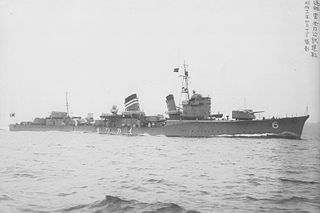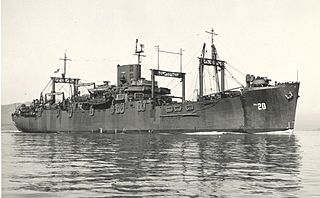
Ikazuchi was the twenty-third Fubuki-class destroyer, or the third Akatsuki class, built for the Imperial Japanese Navy in the inter-war period. When introduced into service, these ships were the most powerful destroyers in the world. They remained formidable weapons systems well into the Pacific War.

HMAS Mildura (J207/M207), named for the city of Mildura, Victoria, was one of 60 Bathurst-class corvettes constructed during World War II, and one of 36 initially manned and commissioned by the Royal Australian Navy (RAN). The ship was laid down by Morts Dock & Engineering Co in 1940 and commissioned into the RAN in 1941.

USS Parrott (DD-218) was a Clemson-class destroyer in the United States Navy during World War II and was the second ship named for George Fountain Parrott.

Empire Sandy is a tall ship providing chartered tours for the public from Toronto, Canada. She was built as an Englishman/ Larch Deep Sea-class tugboat for war service by the British government in 1943. After the end of World War II she was renamed Ashford and then Chris M before reverting to the original name of Empire Sandy and being converted to a schooner.

HMAS Bathurst (J158), named for the city of Bathurst, New South Wales, was the lead ship of 60 Bathurst-class corvettes constructed during World War II and one of 20 built for the Admiralty but manned by personnel of and commissioned into the Royal Australian Navy (RAN). Constructed during 1940, the ship spent most of her early career operating with the British Eastern Fleet in the Indian Ocean. She returned to Australian waters in late 1944, then was deployed to New Guinea in 1945, but saw little action. Bathurst was paid off in 1946, and sold to a Sydney scrap merchant in 1948.

HMAS Ballarat (J184), named for the city of Ballarat, Victoria, was one of 60 Bathurst-class corvettes constructed during World War II and one of 20 built for the Admiralty but manned by personnel of and commissioned into the Royal Australian Navy (RAN).

Inazuma was the twenty-fourth Fubuki-class destroyers, or the fourth of the Akatsuki class, built for the Imperial Japanese Navy in the inter-war period. When introduced into service, these ships were the most powerful destroyers in the world. They remained formidable weapons systems well into the Pacific War.

Ōi (大井) was the fourth of five Kuma-class light cruiser, which served in the Imperial Japanese Navy during World War II. She was named after the Ōi River in Shizuoka prefecture, Japan. Designed as a command vessel for a destroyer squadron, she was converted into a torpedo cruiser with forty torpedo launch tubes in a plan abandoned by the Japanese Navy in 1942. During most of the Pacific War, she was used primarily as a fast troop transport and was sunk by a United States Navy submarine in 1944.

USS President Hayes (APA-20) was a President Jackson-class attack transport that saw service with the US Navy in World War II. It was named for Rutherford B. Hayes, 19th U.S. president.

HMS Carlisle was a C-class light cruiser of the Royal Navy, named after the English city of Carlisle. She was the name ship of the Carlisle group of the C-class of cruisers. Carlisle was credited with shooting down eleven Axis aircraft during the Second World War and was the top scoring anti-aircraft ship in the Royal Navy.

The Cadmus class was a six-ship class of 10-gun screw steel sloops built at Sheerness Dockyard for the Royal Navy between 1900 and 1903. This was the last class of the Victorian Navy's multitude of sloops, gunvessels and gunboats to be constructed, and they followed the traditional pattern for 'colonial' small warships, with a full rig of sails. After them, the "Fisher Reforms" of the Navy ended the construction and deployment of this type of vessel. All of the class survived until the 1920s, remaining on colonial stations during World War I.

HMS Thracian was an S-class destroyer built for the Royal Navy during the First World War.
HMS Colne was a Thornycroft type River-class destroyer ordered by the Royal Navy under the 1903–1904 Naval Estimates. Named after the River Colne in eastern England, north east of London, she was the first ship to carry this name in the Royal Navy.

HMS Chelmer was a Thornycroft-type River-Class destroyer ordered by the Royal Navy under the 1903–1904 Naval Estimates. Named after the River Chelmer in eastern England, north-east of London, she was the first ship to carry this name in the Royal Navy.
Trabajador was a 111 foot (33.8 m) tug launched in 1931 from the Hong Kong and Whampoa Dock for Visayan Stevedore-Transportation Company and registered as a United States vessel in Iloilo, Philippines.
USS Banaag (YT-104) was a harbor tug of the United States Navy that served during World War II.
HMS Cornflower was an Arabis-class sloop of the Royal Navy and from 1933 the Hong Kong Naval Volunteer Force (HKNVR).
HMS St Aubin was a Saint-class tug launched in 1918.
Ranger was an ocean-going tugboat commandeered by the United States Navy during the Second World War.













